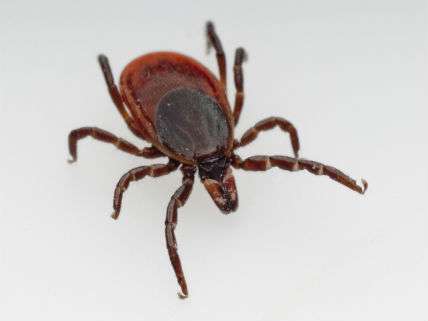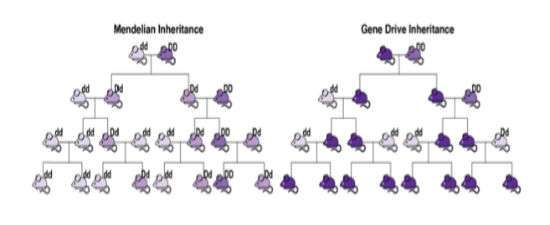CORRECTION: Gene Drives, the Precautionary Principle, and the National Academy of Sciences
Go slow and let more people suffer and die

How sardonic! On the very day that the New York Times reports on MIT evolutionary biologist Kevin Esvelt's discussion with Nantucket residents about using gene-drives to rid the island of the scourge of Lyme disease*, the National Academy of Sciences (NAS) publishes a report arguing that the technology should not be used yet. The NAS report, Gene Drives on the Horizon: Advancing Science, Navigating Uncertainty, and Aligning Research with Public Values, basically endorses a highly precautionary approach in which new technologies are not permitted to be deployed until the most frightened objectors have assented.
Some 40 percent of Nantucket residents have had Lyme disease which is spread via bites from deer ticks. The ticks themselves acquire the microbe at an earlier stage of their life cycles when they bite white-footed mice. Esvelt proposes to use the new CRISPR genome-editing technique to create mice that are immune to the Lyme disease pathogen. The technically sweet aspect of this is that this immunological resistance trait can be linked up in a gene-drive which ensures that the trait is passed onto all offspring instead of the usual half. In sexually reproducing species, offspring inherit half of their genes from each parent; a gene-drive is a construct inherited from one parent that transforms the corresponding gene from the other to match. In this case, current genes that permit infection by Lyme pathogens would be transformed into genes for resistance.
Esvelt proposed releasing the genome-edited Lyme resistant mice first onto an unihabited island to breed with the natural population for two years to see if the gene-drive worked. If it did, he would breed up thousands of modified mice to be released on Nantucket where the genes for resistance to Lyme disease would spread. What's not to like?

The new NAS report outlines a slow precautionary series of scientific and regulatory hurdles that each proposed gene-drive would have to surmount before being deployed. Actually, Esvelt was already implementing a good bit of what the NAS is recommending: he is consulting with local residents and the first release would be in an isolated island to check on the efficacy of the gene-drive.
Certainly we all need to be aware of the unintended consequences of new technologies. However, the fact that all of the potential downsides of a new technology can never be entirely anticipated, does not, therefore, require that we should forego a tech's intended upsides such as disease prevention. Researchers have already shown that it is possible to devise gene-drives that reduce the populations of disease-causing mosquitoes or make them immune to malaria. A surer guide to safe progress is the proactionary principle:
People's freedom to innovate technologically is highly valuable, even critical, to humanity …. Assess risks and opportunities according to available science, not popular perception. Account for both the costs of the restrictions themselves, and those of opportunities foregone. Favor measures that are proportionate to the probability and magnitude of impacts, and that have a high expectation value. Protect people's freedom to experiment, innovate, and progress.
Naturally, some anti-technology activists thought the NAS report was insufficiently precautionary. For example, in its Stop the Gene Bomb! press release, the ever-alarmed ETC Group calls for—wait for it—"a global moratorium on the release and commercial development of gene drives."
A moratorium is just the thing needed by the millions who suffer and die from malaria annually and the thousands who will be born with shrunken brains due to Zika virus infections, not to mention Nantucket residents who endure Lyme disease.
*CORRECTION: Professor Esvelt contacted me to explain that I had misunderstood his proposal. He would not release mice engineered with gene-drives, but instead is proposing to genetically engineer mice to be resistant to the Lyme pathogen and then release them to breed normally with regular mice on an isolated island. In this case, the disease-resistance gene would transmit normally as the engineered mice bred with the natural population. The idea is to test to see if spreading the resistance gene through normal sexual transmission would reduce the number of ticks infected with the Lyme pathogen.
My more egregious error is my implication that Esvelt thinks the NAS report recommendations are too onerous. In fact, Esvelt evidently thinks that the NAS report is insufficiently precautionary. For more background on his views, see his article, Strategies for Responsible Gene Editing. With due respect, I believe that he has fallen for the Asilomar fallacy. As I explain in my book, The End of Doom:
In 1976, the New York Times Magazine published an alarming front-page article, "New Strains of Life—or Death," by Cornell University biochemist Liebe Cavalieri. Cavalieri asserted, among other horrors, that gene splicing could lead to accidental outbreaks of infectious cancer. "In the case of recombinant DNA, it is an all or none situation—only one accident is needed to endanger the future of mankind," he warned.
Also in 1976, Alfred Vellucci, the mayor of Cambridge, Massachusetts, guided by the left-leaning group Science for the People, wanted to ban gene-splicing research in his city. Of course, Cambridge is home to Harvard University and the Massachusetts Institute of Technology. "We want to be damned sure the people of Cambridge won't be aected by anything that could crawl out of that laboratory," Vellucci told the New York Times. He added, "They may come up with a disease that can't be cured—even a monster. Is this the answer to Dr. Frankenstein's dream?" There is no little irony that today Cambridge promotes itself as "one of the world's major biotech centers." Needless to say, more than forty years after gene splicing was invented, no plagues, much less epidemics of infectious cancer, have emerged from the world's biotech labs.
In the context of this furor, some 140 molecular biologists convened in 1975 at the Asilomar Conference Grounds in Pacific Grove, California, to draft guidelines for conducting gene-splicing experiments. They self-consciously thought that they were avoiding what they saw as the mistakes made a generation earlier by Manhattan Project nuclear physicists when they unleashed the power of the atom. The initially restrictive guidelines have been greatly relaxed, not least because it turns out that microorganisms are natural and promiscuous exchangers of genes.
Reflecting later on the hysteria and rush to regulate, James Watson, codiscoverer of the double-helix structure of DNA, for which he won the Nobel Prize, succinctly noted, "Scientifically I was a nut. There is no evidence at all that recombinant DNA poses the slightest danger." Similarly, biophysicist Burke Zimmerman, who participated in the congressional debates over regulating biotechnology, concluded, "In looking back, it would be hard to insist that a law was necessary, or, perhaps, that guidelines were necessary."
However, once fears are raised, they are hard to allay, especially if some groups find them useful for advancing other agendas.
And sure enough, as I note above, the alarmist ETC Group in response to the NAS report immediately analogizes gene-drives to the development of nuclear weapons. The model of public consultation has already resulted in the rejection by residents in the Florida Keys of a field trial in which mosquitoes genetically engineered to spread a lethal gene to species that carry dengue, chikungunya, Zika, and malaria pathogens would be released. Field trials of those engineered mosquitoes in Brazil, Panama, and the Cayman Islands have shown that such releases greatly reduce the populations of the disease-carrying pests. These field trials are significantly different from gene-drives because there is no permanent transmission of the engineered genes. (How could there be since the engineered gene kills mosquitoes as larva?)
As I have made clear for years, I am no fan of the precautionary principle, which in The End of Doom I tendentiously summarize as: "Never do anything for the first time."
How to regulate an open access commons is always a perplexing problem. Esvelt is one of the leading developers and thinkers in this area and his views deserve careful consideration.
In any case, I am truly sorry for the confusion I have caused, and very much regret the errors in my reporting.


Show Comments (110)